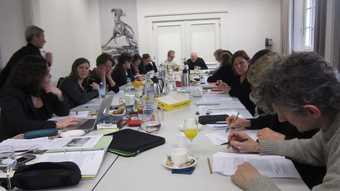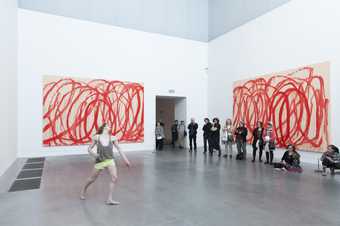‘Performance at Tate’ aimed to research, document and make public the role performance – in all its forms – has played in the history of modern and contemporary art at Tate since the 1960s. It studied the museum’s practices of collecting, displaying, documenting and sharing performance and explored how performance practices may reframe conventional understanding of an art collection. ‘Performance at Tate’ also examined audience engagement and other issues around spectatorship by exploring ways of recording and interpreting responses to performance, both historically and with new experimental approaches. Funded by the Arts and Humanities Research Council (AHRC), this two-year project was a collaboration between the Centre for Intermedia at the Department of English at the University of Exeter and Tate. The outputs include a scholarly online publication, Performance at Tate: Into the Space of Art with thematic essays and around one hundred case studies drawn from Tate’s collection and programmes, an edited book featuring new approaches to the subject and interviews with artists and curators, a project documentation blog, a workshop (2015), an international conference (2016) and a number of journal articles and papers.
The project took as its starting point the 1960s when performance emerged as a recognised, even if contested and mercurial, genre and when the Tate Gallery, as it then was, both acquired artworks of a performative nature and hosted a number of performances and actions. Tate has continued to collect and stage these types of artworks to the present day. From 2003, with the introduction of Tate Live and more recently the opening of the Tanks at Tate Modern, Tate’s programming of performance has represented a concerted effort to engage the art form and has carved a unique niche for Tate as an arts institution. The museum now holds a diverse range of documents, including films, photographs, artist statements, and correspondence, relating to over two hundred performances by artists such as Carlos Amorales, Joseph Beuys (as illustrated above), Trisha Brown, John Cage, Merce Cunningham, the Guerrilla Girls, Sung Hwan Kimn, Joan Jonas, Surasi Kusalwong, Suzanne Lacy, Christian Marclay, Cai Guo Qiang, and Tania Bruguera, to name a few. Some of these included live performance; others were born digital. Some had audiences; others were interactive and user-led. Some were documented extensively, by well-known photographers; one piece – Tino Seghal’s This is Propaganda 2002 – has no conventional documentation.
Tate’s renewed and increased commitment to a performance programme requires that it now look back at what it has established curatorially throughout the years, while also looking forward at developing new strategies for performance, including the development of interdisciplinary and participatory methodologies for performance documentation to ensure that the new commissions in the Tanks and elsewhere at Tate can effectively generate future legacies and push the boundaries of performance.
The project has thus explored both historic and more recent examples of performance in order to arrive at a fresh understanding of the place of performance at Tate and in art museums more generally. Through researching the sometimes ignored or little known performative aspects of a wide range of artworks in the collection, the project has also sought to arrive at new understandings of the sometimes fluid and paradoxical relationship between art objects, actions, and documentation. It is our hope that this attention to performance and the performative will stimulate a reappraisal of the narratives of modern and contemporary art that can be told within a museum context.
The project was guided by an Academic Advisory Board comprising:
- Professor Claire Bishop, The Graduate Center, City University of New York
- Professor Adrian Heathfield, University of Roehampton
- Professor Katja Kwastek, VU University Amsterdam
- Dr Ross Parry, University of Leicester
To enquire about the project please contact Gabriella Giannachi, Professor of Performance and New Media, Centre for Intermedia, University of Exeter (G.Giannachi@exeter.ac.uk).
Updated December 2016


